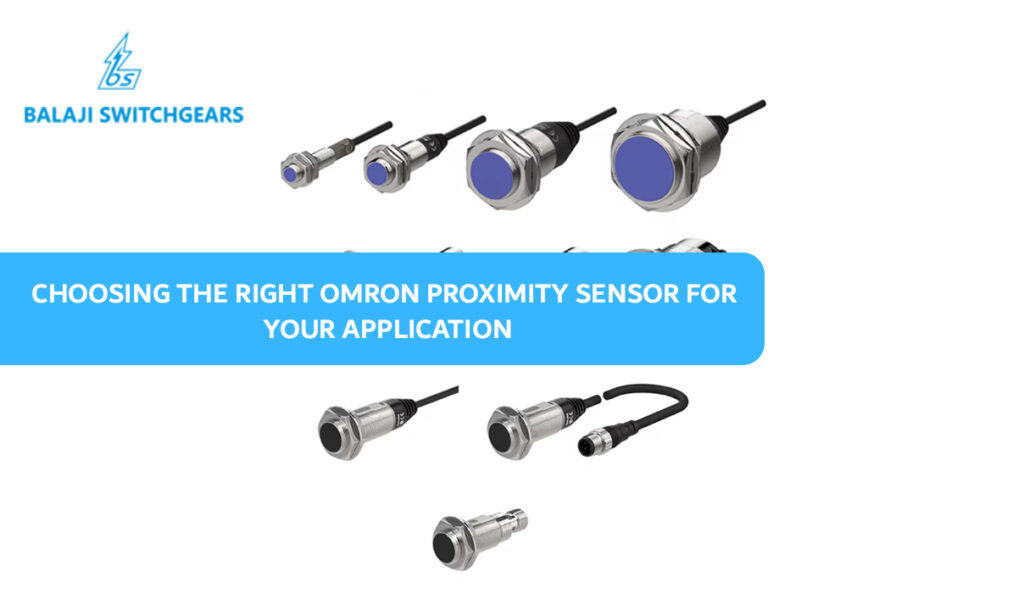In the world of industrial automation, proximity sensors play a crucial role in detecting the presence or absence of objects within a specific range without any physical contact. Omron, a leader in industrial automation solutions, offers a variety of proximity sensor types to meet diverse application needs. This guide will help you understand the different Omron proximity sensor types and how to choose the right one for your specific application, brought to you by Balaji Switchgears.
Understanding Proximity Sensors
Proximity sensors are devices that detect the presence or movement of an object (target) within their sensing range. They are widely used in manufacturing, robotics, and automation industries to ensure efficient and accurate operation of machinery. Omron provides several types of proximity sensors, each designed for specific applications and environments.
Types of Omron Proximity Sensors
- Inductive Proximity Sensors
- Capacitive Proximity Sensors
- Photoelectric Proximity Sensors
- Magnetic Proximity Sensors
Let’s delve into each type to understand their unique characteristics and applications.
Inductive Proximity Sensors
Inductive proximity sensors are used to detect metallic objects. They operate based on the principle of electromagnetic induction. When a metallic target enters the sensor’s magnetic field, it induces a current in the sensor’s coil, triggering the detection signal.
Applications:
- Detection of metal parts in automated assembly lines.
- Positioning and presence detection in industrial robots.
- Monitoring metal objects in conveyor systems.
Advantages:
- High durability and reliability in harsh industrial environments.
- Excellent resistance to dirt, oil, and other contaminants.
Capacitive Proximity Sensors
Capacitive proximity sensors can detect both metallic and non-metallic objects, including liquids, powders, and granular materials. They work by detecting changes in capacitance when a target approaches the sensor.
Applications:
- Level detection of liquids and solids in containers.
- Detection of non-metallic materials such as plastics and glass.
- Sensing in packaging and food processing industries.
Advantages:
- Versatile in detecting a wide range of materials.
- Can operate through non-metallic containers and walls.
Photoelectric Proximity Sensors
Photoelectric proximity sensors use a light beam (visible or infrared) to detect the presence of an object. They consist of a transmitter (light source) and a receiver (photo detector). When an object interrupts the light beam, the sensor detects the change.
Applications:
- Object detection in material handling systems.
- Presence detection in automated doors and gates.
- Counting objects on production lines.
Advantages:
- Long sensing range compared to other sensor types.
- Capable of detecting transparent and opaque objects.
Magnetic Proximity Sensors
Magnetic proximity sensors detect the presence of magnetic fields. They are typically used to detect magnets embedded in objects. These sensors are ideal for applications where contactless detection is required.
Applications:
- Position sensing in hydraulic cylinders.
- Door and lid detection in appliances and machinery.
- Speed sensing in rotating machinery.
Advantages:
- Contactless operation reduces wear and tear.
- High reliability in dirty or wet environments.
Choosing the Right Omron Proximity Sensor
Selecting the right Omron proximity sensor for your application involves considering several factors:
- Target Material: Determine whether the target object is metallic or non-metallic. Inductive sensors are suitable for metallic targets, while capacitive sensors can detect both.
- Sensing Distance: Evaluate the required sensing range. Photoelectric sensors offer longer sensing distances compared to inductive and capacitive sensors.
- Environmental Conditions: Consider the operating environment. For harsh conditions with dirt, oil, or moisture, inductive and magnetic sensors are ideal due to their robustness.
- Application Requirements: Identify specific application needs such as detection accuracy, response time, and mounting constraints.
- Sensor Size and Shape: Choose a sensor size and shape that fits the installation area. Omron offers various sizes and configurations to match different application requirements.
Conclusion
Omron proximity sensors provide reliable and efficient solutions for a wide range of industrial applications. By understanding the different Omron proximity sensor types and considering your specific application requirements, you can choose the right sensor to enhance the performance and reliability of your automation systems.
Balaji Switchgears is proud to offer a comprehensive selection of Omron proximity sensors to meet your industrial needs. Our team of experts is available to assist you in selecting the best sensor for your application, ensuring optimal performance and longevity. Visit us today to explore our range of Omron sensors and find the perfect solution for your automation challenges.


Your blog is a treasure trove of valuable insights and thought-provoking commentary. Your dedication to your craft is evident in every word you write. Keep up the fantastic work!
Somebody essentially help to make significantly articles Id state This is the first time I frequented your web page and up to now I surprised with the research you made to make this actual post incredible Fantastic job